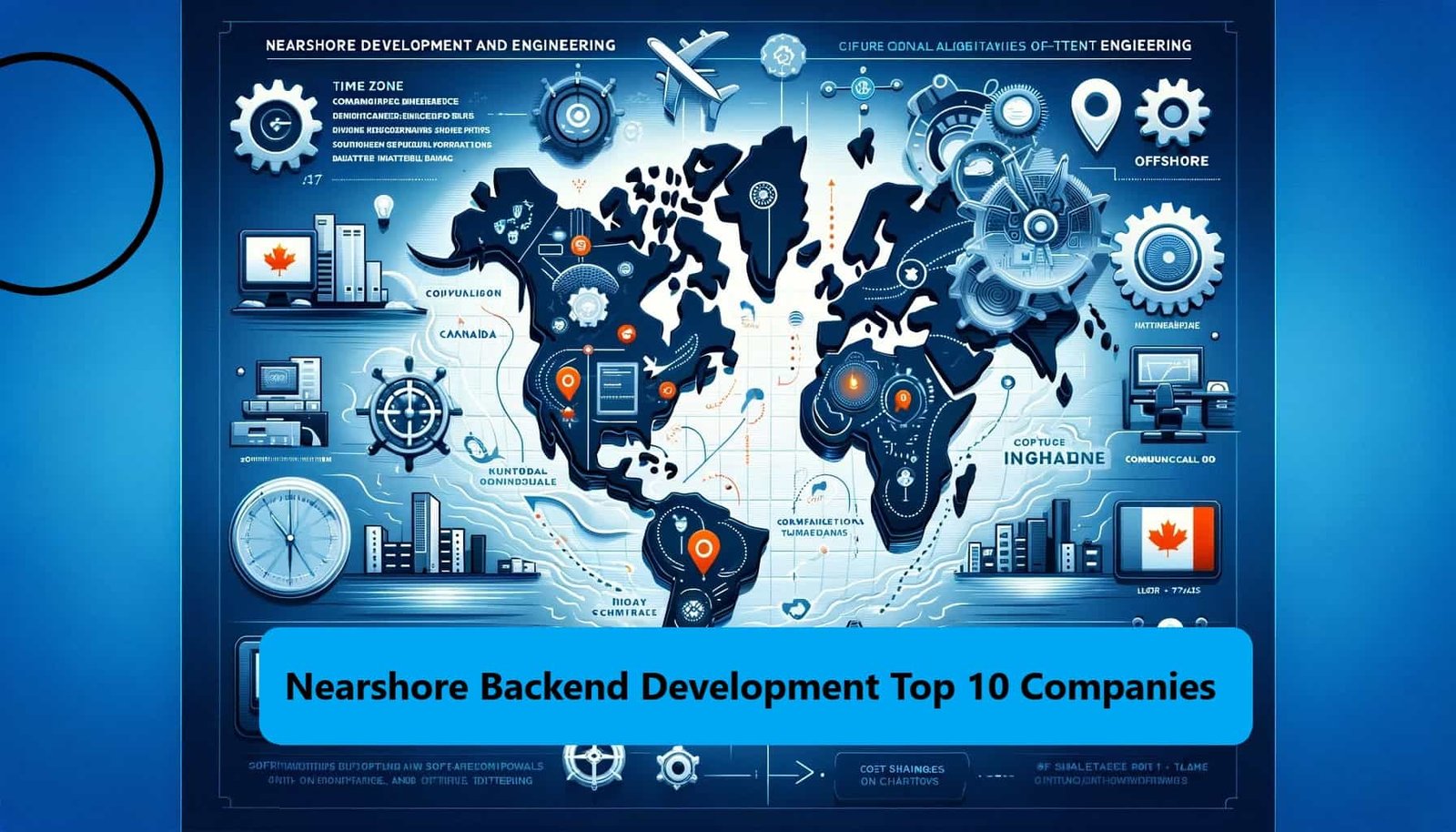Nearshore backend development offers businesses cost-effective, culturally aligned partnerships with skilled developers in similar time zones. This article highlights the top 10 nearshore backend development companies in the USA, showcasing their expertise in technologies like cloud infrastructure and microservices. By leveraging reduced time zone gaps, competitive rates, and specialized talent, companies can enhance their backend systems efficiently. Additionally, cultural alignment ensures seamless collaboration and integration, driving successful project outcomes. Whether scaling rapidly or seeking specialized skills, nearshore partners provide the flexibility and reliability needed for robust and scalable backend solutions. Overcoming challenges such as managing distributed teams and ensuring continuous communication, these top firms deliver high-quality, secure, and innovative backend development services tailored to meet diverse business needs.
1. Introduction
1.1 Definition of Nearshore Backend Development
Nearshore backend development refers to collaborating with software teams based in countries that share similar or adjacent time zones to the United States. These teams work on critical server-side tasks, including database management, server-side logic, and application programming interfaces (APIs). This arrangement differs from offshore outsourcing, where partners may be several time zones away and face communication hurdles. By choosing a nearshore approach, companies reduce logistical barriers and keep project oversight efficient.
Backend capabilities play a central role in driving smooth digital experiences. Whether a firm needs secure data transactions or real-time communication between various applications, well-structured server-side architecture is essential. Effective database strategies, robust APIs, and stable server logic all contribute to reliable products and services that stand out in competitive markets.
1.2 Why U.S. Businesses Choose Nearshore
Many U.S.-based organizations select nearshore backend development services to minimize the negative effects of large time differences. Real-time collaboration is easier when project teams in the United States and nearshore developers share work hours. This overlap supports timely status updates, quicker feedback cycles, and cohesive teamwork that ultimately results in a better end product.
Moreover, nearshore collaborations often benefit from cultural and language compatibility. Working with professionals who have a solid grasp of English and familiarity with U.S. business practices can streamline communications. This alignment builds trust and facilitates negotiations, making it more likely that all parties work toward shared objectives efficiently.
1.3 Purpose of This Article
This article aims to demonstrate how nearshore partnerships help streamline projects by offering skilled developers who understand modern backend frameworks and processes. In addition, it presents a carefully selected list of top-rated companies in the United States that excel at nearshore backend development.
Readers can expect practical information about the advantages of engaging with nearshore teams, key factors to consider when evaluating partnerships, and guidance on choosing the right company for their specific needs. Ultimately, the goal is to empower decision-makers with insights into why nearshore backend development has become a strategic advantage for many U.S. organizations.
2. Key Advantages of Nearshore Backend Development 🚀
2.1 Reduced Time Zone Gaps ⏰
One of the standout benefits of nearshore backend development is the minimal time zone difference between the United States and nearby countries. This proximity allows for real-time communication and seamless collaboration, which is crucial for the timely progression of projects. Teams can engage in synchronous meetings, conduct daily stand-ups, and provide immediate feedback, reducing the delays often encountered with offshore partners. This alignment ensures that project milestones are met efficiently, fostering a more agile development environment where issues can be addressed promptly without waiting for the next business day.
2.2 Cost Efficiency 💰
Competitive Developer Rates Compared to Onshore Teams
Nearshore development offers significant cost savings without sacrificing quality. Developers in nearshore locations typically charge lower rates than their onshore counterparts, enabling firms to allocate their budgets more effectively. For instance, hiring a backend developer in Latin America can result in up to 40% cost savings compared to hiring domestically in the U.S. These savings allow businesses to invest more in other critical areas such as innovation, marketing, or expanding their service offerings.
Comparison with Offshore Alternatives
While offshore development also presents cost benefits, nearshore partnerships often provide a better overall value proposition. The reduced time zone differences and cultural alignment mitigate many of the communication and project management challenges associated with offshore teams. This means that nearshore solutions can deliver similar cost advantages to offshore options but with enhanced efficiency and fewer operational hurdles, ultimately leading to a higher return on investment (ROI).
2.3 Access to Specialized Talent 🎯
Nearshore backend development partners offer access to a diverse pool of highly skilled developers with expertise in specialized areas such as cloud infrastructure, microservices, and API development. This specialized talent is essential for building robust and scalable backend systems that meet the complex needs of modern businesses. For example, a nearshore team proficient in AWS and Kubernetes can help implement scalable cloud solutions, while those experienced in microservices can design flexible architectures that enhance system resilience and performance. This access ensures that projects are handled by experts who can deliver high-quality, innovative solutions tailored to specific business requirements.
2.4 Cultural Alignment 🤝
Cultural compatibility is a critical factor in the success of nearshore collaborations. Teams that share similar cultural values and business practices are more likely to integrate smoothly with U.S. firms, fostering a collaborative and productive working relationship. This alignment reduces the potential for misunderstandings and enhances mutual trust, making it easier to achieve common objectives. Additionally, cultural similarity often translates into better teamwork, higher morale, and increased motivation, as team members feel more comfortable and engaged when working within a familiar cultural framework. This harmonious working environment not only boosts productivity but also contributes to the overall success and longevity of the partnership.
3. What to Look for in a Nearshore Partner 🌟
3.1 Technical Expertise 🛠️
When selecting a nearshore backend development partner, it’s essential to evaluate their technical proficiency. Ensure that the team is well-versed in the backend frameworks and technologies relevant to your project, such as Node.js, Python, Java, or .NET. Reviewing case studies and client testimonials can provide insights into their ability to handle similar projects successfully. Additionally, certifications from recognized platforms like AWS, Microsoft Azure, or Google Cloud can indicate a solid foundation in current industry practices and a commitment to ongoing professional development.
3.2 Communication and Project Management 📈
Effective communication is the cornerstone of any successful partnership. Look for a nearshore partner that prioritizes clear and consistent communication channels. This includes having a dedicated project manager or liaison who oversees the project’s progress and serves as the primary point of contact. Familiarity with project management methodologies such as Agile or Scrum can also enhance collaboration and ensure that the project stays on track. Regular updates, transparent reporting, and responsiveness to inquiries are key indicators of a partner’s commitment to maintaining open lines of communication.
3.3 Security and Compliance 🔒
Data security and regulatory compliance are paramount, especially when dealing with sensitive information. Verify that the nearshore partner adheres to stringent security protocols, including data encryption, regular security audits, and compliance with relevant regulations such as HIPAA, GDPR, or SOC 2. Understanding their approach to secure coding practices and vulnerability assessments will help ensure that your backend systems are protected against potential threats. Additionally, clear policies on data ownership and intellectual property rights are essential to safeguard your firm’s proprietary information.
3.4 Scalability and Flexibility 📊
Your business needs may evolve over time, and your backend development partner should be able to accommodate these changes. Assess whether the partner can scale their team size and resources in response to project demands. Flexibility in contract terms, such as the ability to adjust the scope of work or extend the engagement period, can provide the necessary adaptability to support your growing business needs. A partner that offers both short-term and long-term engagement options can help ensure that your backend infrastructure remains robust and scalable as your company expands.
4. Top 10 Nearshore Backend Development Companies in the USA 🌟
Selecting the right nearshore backend development partner is crucial for the success of your projects. Below is a curated list of the top 10 nearshore backend development companies in the USA, each renowned for their expertise, reliability, and exceptional service offerings.
4.1 BairesDev
- Overview: Founded in 2009 and headquartered in San Francisco, BairesDev has rapidly grown to become a leading nearshore software development company. They specialize in providing top-tier backend development services to a diverse range of industries.
- Services Offered: BairesDev offers expertise in backend frameworks such as Node.js, Python, Java, and .NET. They serve industries including fintech, healthcare, e-commerce, and more, with a strong emphasis on scalable and secure backend solutions.
- Unique Strengths: Known for their rigorous talent selection process, BairesDev ensures access to highly skilled developers. Their ability to rapidly scale teams based on project needs and maintain a high client retention rate sets them apart in the competitive market.
4.2 Globant
- Overview: Globant, established in 2003 and based in Buenos Aires, Argentina, has a significant nearshore presence in the USA. They are recognized for their innovative approach to software development and digital transformation.
- Services Offered: Specializing in backend development with technologies like Java, Python, and Ruby on Rails, Globant serves sectors such as media, finance, and technology. Their comprehensive services include API development, cloud integration, and microservices architecture.
- Unique Strengths: Globant’s focus on cutting-edge technologies and their strong emphasis on agile methodologies enable them to deliver high-quality, flexible solutions. Their global expertise and collaborative approach ensure seamless integration with client teams.
4.3 PSL Corp
- Overview: Founded in 1999 and headquartered in Medellín, Colombia, PSL Corp has established itself as a premier nearshore software development partner for U.S. businesses. They pride themselves on their deep technical expertise and commitment to excellence.
- Services Offered: PSL Corp provides backend development using Java, .NET, Python, and more. They cater to industries such as banking, insurance, and telecommunications, offering services like database optimization, server-side logic, and API integrations.
- Unique Strengths: PSL Corp is renowned for their strong engineering culture and focus on continuous improvement. Their ability to deliver robust, scalable backend solutions with a high degree of customization makes them a trusted partner for complex projects.
4.4 UruIT
- Overview: UruIT, founded in 2008 and based in Montevideo, Uruguay, specializes in providing top-quality software development services to North American clients. They emphasize innovation and customer satisfaction in all their projects.
- Services Offered: UruIT excels in backend development with technologies such as Node.js, Python, and Java. Their services include cloud services, database management, and API development, serving clients in healthcare, education, and fintech.
- Unique Strengths: UruIT’s dedication to building long-term client relationships and their flexible engagement models allow them to adapt to varying project requirements. Their focus on delivering high-performance backend systems ensures reliability and efficiency for their clients.
4.5 Arkano Software
- Overview: Arkano Software, established in 2008 and headquartered in Montevideo, Uruguay, offers comprehensive software development services with a strong nearshore presence in the USA. They are committed to delivering innovative and effective backend solutions.
- Services Offered: Arkano specializes in backend frameworks like Python, Java, and .NET. They provide services such as microservices architecture, API development, and cloud integration, catering to industries including retail, healthcare, and logistics.
- Unique Strengths: Arkano Software is known for their agile project management and transparent communication practices. Their ability to deliver customized backend solutions swiftly and efficiently helps clients achieve their business objectives with minimal delays.
4.6 Intellectsoft
- Overview: Founded in 2007 and based in Palo Alto, California, Intellectsoft provides nearshore software development services with a focus on delivering high-quality backend solutions. They serve a global clientele with diverse technological needs.
- Services Offered: Intellectsoft offers backend development using technologies such as Java, Python, and Node.js. Their services include API development, database management, and cloud services, targeting industries like finance, healthcare, and retail.
- Unique Strengths: Intellectsoft stands out for their commitment to innovation and their ability to handle complex, large-scale projects. Their robust project management processes and dedication to quality ensure that clients receive reliable and scalable backend systems.
4.7 Ciklum
- Overview: Ciklum, established in 2002 and headquartered in Kyiv, Ukraine, is a global software development and IT outsourcing company with a strong nearshore presence in the USA. They are known for their extensive expertise and client-centric approach.
- Services Offered: Ciklum provides backend development with a focus on Java, .NET, Python, and Ruby on Rails. They offer services such as API integration, database optimization, and cloud infrastructure management, serving industries like automotive, finance, and healthcare.
- Unique Strengths: Ciklum’s ability to deliver tailored solutions and their emphasis on building long-term partnerships contribute to their strong client satisfaction rates. Their global talent pool and scalable development teams allow them to meet diverse project requirements effectively.
4.8 Daxx
- Overview: Daxx, founded in 1993 and headquartered in Amsterdam, Netherlands, offers nearshore software development services with a significant footprint in the USA. They specialize in providing dedicated development teams tailored to client needs.
- Services Offered: Daxx excels in backend development using technologies such as Java, .NET, Python, and Node.js. Their services include API development, database management, and cloud services, catering to industries like fintech, healthcare, and e-commerce.
- Unique Strengths: Daxx is recognized for their flexible engagement models and their ability to provide dedicated, highly skilled development teams quickly. Their focus on building strong client relationships and delivering consistent quality makes them a preferred partner for many U.S. businesses.
4.9 Iflexion
- Overview: Iflexion, established in 1999 and based in Houston, Texas, provides nearshore backend development services with a focus on delivering high-performance solutions. They have a proven track record of serving a wide range of industries effectively.
- Services Offered: Iflexion offers backend development expertise in Java, .NET, Python, and PHP. Their services include API development, microservices architecture, and database optimization, serving clients in sectors such as healthcare, finance, and logistics.
- Unique Strengths: Iflexion is known for their deep technical expertise and their ability to handle complex backend challenges. Their commitment to quality and customer satisfaction ensures that clients receive reliable and efficient backend systems tailored to their specific needs.
4.10 Endava
- Overview: Endava, founded in 2000 and headquartered in London, UK, provides nearshore backend development services with a strong presence in the USA. They focus on delivering transformative technology solutions to drive business growth.
- Services Offered: Endava specializes in backend development using technologies like Java, .NET, Python, and Node.js. They offer services such as API development, cloud integration, and database management, targeting industries including banking, insurance, and telecommunications.
- Unique Strengths: Endava’s focus on digital transformation and their ability to integrate innovative technologies into backend systems make them a valuable partner for businesses looking to modernize their IT infrastructure. Their collaborative approach and commitment to excellence ensure high-quality outcomes for their clients.
5. Potential Challenges and How to Overcome Them 🛡️
5.1 Managing Distributed Teams 🌍
Collaborating with nearshore teams requires effective management strategies to ensure alignment and productivity. Utilize project management tools like Jira, Trello, or Asana to track progress and assign tasks clearly. Implement regular video conferences and virtual meetings to maintain open lines of communication and foster a sense of teamwork. Establishing clear roles and responsibilities from the outset can help mitigate misunderstandings and keep the project moving forward smoothly.
5.2 Intellectual Property Concerns 🔐
Protecting your intellectual property (IP) is crucial when working with external development partners. Ensure that all agreements include comprehensive IP clauses that clearly define ownership rights. Implement strict access controls and use secure platforms for sharing sensitive information. Additionally, require all team members to sign non-disclosure agreements (NDAs) to safeguard your proprietary data and maintain confidentiality throughout the project lifecycle.
5.3 Continuous Communication 📡
Maintaining consistent and transparent communication is essential for the success of nearshore collaborations. Establish regular check-ins and status updates to monitor progress and address any issues promptly. Encourage an open-door policy where team members feel comfortable raising concerns or suggesting improvements. Leveraging collaborative tools like Slack, Microsoft Teams, or Zoom can enhance real-time communication and ensure that everyone remains on the same page.
6. Tips for Maximizing Success with Nearshore Partners 🌟
6.1 Clear Goals and Metrics 🎯
Define your project objectives and establish clear metrics for success from the beginning. Outline specific milestones, deliverables, and key performance indicators (KPIs) to measure progress effectively. Communicate these goals to your nearshore partner to ensure that both teams are aligned and working towards the same outcomes. Regularly review these metrics to assess performance and make necessary adjustments to keep the project on track.
6.2 Ongoing Feedback Loop 🔄
Create a continuous feedback loop to ensure that the development process remains aligned with your expectations. Schedule regular review sessions and provide constructive feedback to guide the nearshore team. Encourage open dialogue and collaborative problem-solving to address any challenges that arise. This iterative approach helps refine the project incrementally, leading to a final product that meets your quality standards and business needs.
6.3 Emphasize Cultural Fit 🤝
Fostering a strong cultural fit between your in-house team and the nearshore partner can significantly enhance collaboration and project success. Encourage team-building activities and promote mutual understanding of each other’s work cultures and practices. This alignment can lead to better communication, increased trust, and a more cohesive working relationship, ultimately driving the project towards successful completion.
7. Conclusion 🏁
Nearshore backend development presents a strategic advantage for U.S. businesses seeking to enhance their digital infrastructure with skilled, cost-effective, and culturally aligned partners. By leveraging the benefits of reduced time zone gaps, cost efficiency, access to specialized talent, and cultural alignment, companies can achieve robust and scalable backend solutions that drive business growth.
When selecting from the top 10 nearshore backend development companies highlighted in this article, consider how each firm’s expertise, services, and unique strengths align with your specific project requirements. A thoughtful and thorough selection process, combined with clear communication and defined goals, will pave the way for a successful partnership that delivers high-quality backend systems tailored to your business needs.
FAQ
1. What is the nearshore to the US?
Nearshore to the US refers to countries that are geographically close to the United States, typically within the same or adjacent time zones, which facilitates easier business operations, communication, and collaboration. In the context of the US, nearshore regions primarily include countries in Latin America, such as Mexico, Costa Rica, and Brazil, as well as Canada. These locations offer proximity advantages that can lead to more synchronized working hours and cultural affinities with the US.
2. What is nearshore software development services?
Nearshore software development services involve contracting a software development team based in a nearby country to perform various tasks related to software development, including backend development, front-end development, full-stack development, and quality assurance testing. The nearshore model combines the cost-effectiveness of outsourcing with the benefits of similar time zones and cultural similarities, facilitating better communication and collaboration between the client and the service provider.
3. What is the difference between nearshore and offshore software development?
The primary difference between nearshore and offshore software development lies in the geographical proximity and time zone alignment with the client’s location:
- Nearshore software development involves partnering with companies or teams in nearby countries, usually within the same or a closely adjacent time zone. This proximity allows for real-time collaboration, easier communication, and more efficient project management.
- Offshore software development refers to outsourcing work to distant countries, often across different continents and time zones, such as India, China, or Eastern Europe for US-based companies. While offshore development can be more cost-effective due to lower labor costs in these regions, it often comes with challenges related to time zone differences, cultural barriers, and communication hurdles.
4. What is the difference between nearshore and offshore engineering?
Nearshore and offshore engineering both refer to outsourcing engineering tasks, but they differ in their geographic focus and the associated implications:
- Nearshore engineering involves outsourcing engineering work to nearby countries where the time zones and cultural practices are similar to the client’s country. This approach is chosen to improve collaboration, streamline communication, and facilitate project management while still leveraging cost advantages and accessing a wider talent pool.
- Offshore engineering, on the other hand, means outsourcing engineering tasks to far-off countries, typically where there is a significant time zone difference and possibly substantial cultural differences. The main advantage of offshore engineering is the potential for cost savings due to lower labor costs in the offshore location. However, it may also present challenges such as communication barriers, time zone issues, and the need for more rigorous project coordination and management.





